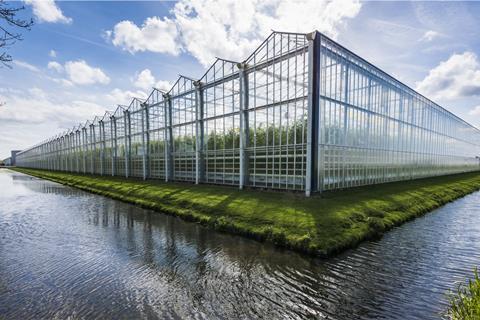From solar greenhouses to powering the next generation of smart technology inside the home, organic photovoltaic cells will revolutionise the way we live
It has long been recognized that the sun represents a virtually unlimited energy source. In light of the growing energy and environmental crisis and the global drive toward renewable energy, the interest in harnessing solar cell technology has skyrocketed. Scientific innovations have resulted in solar power becoming the cheapest source of renewable energy in the world – even undercutting gas and coal in many international markets. It is anticipated that solar energy will dominate over most other forms by 2050.
At the forefront of the rapidly advancing field of photovoltaics are organic semiconductor materials. These form the active layer of organic photovoltaic (OPV) cells. By combining p- and n-type organic semiconducting polymers and/or small molecules, a photovoltaic effect is achieved. In simple terms, the OPV cell can generate electricity through the photovoltaic effect when light radiation corresponding to the energy of the band gap hits the cell.
In contrast to traditional silicon-based solar cells, OPVs are thin, lightweight and can be highly flexible. This, combined with the use of printing technologies that enable OPVs to be manufactured sustainably, cost effectively and at incredibly high throughputs, has resulted in an increased focus on optimising their properties for commercial applications. Additionally, the advent of Chemistry 4.0 – the digital revolution transforming the industry – has only provided further fuel to the development of OPV-based technologies.
The importance of collaboration
As a power source, OPVs offer a low carbon footprint, the shortest energy payback time and the highest power-per-weight ratio of any solar cell technology. A key limitation of OPVs has been low power conversion efficiencies (PCEs) compared with their inorganic counterparts. Scientific advances continue to improve efficiency and pave the way for more widely available OPV-based solar power. Collaboration to increase access to innovative OPV materials is vital to accelerate progress toward this goal and help usher in a new era of sustainable energy.
Once they make the leap from lab to commercial products, OPVs offer the exciting potential to unlock new applications and increase sustainability across a wide range of areas
That’s why Thermo Fisher Scientific and Brilliant Matters, materials science experts and OPV materials supplier, have partnered to produce a joint portfolio of high-quality OPV materials that can fast-forward the development of more environmentally friendly OPV-based products.
A supply of high-quality and reliable OPV materials is essential for laboratories seeking to optimise OPV cells for commercial purposes. Purity and minimal batch-to-batch variation in the manufacture of p- and n-type materials ensures reliable results and good quality end products. This is especially noticeable as projects begin to scale up, at which time the smallest design errors or impurities begin to have drastic effects. Additionally, high-performing OPV cells are often first developed using production methods that cannot be transferred to industry, which inhibits large-scale production. For example, they may be processed using halogenated solvents that cannot be scaled up due to toxicity concerns. The lifetime of a material is also crucial and influenced by many factors, with material quality at its heart. Consequently, it is essential to have a partner that can guarantee a reproducible and reliable supply of high-performance OPV materials that can be processed using industry-friendly manufacturing methods.
When innovation starts in small, agile companies, a partner with a detailed understanding of the scientific market and a global network can help innovations find their way into the hands of those who can generate the most benefit from them. This is the basis of the collaboration between Thermo Fisher and Brilliant Matters to create a portfolio of leading OPVs. As such, the collaboration aims to widen access to high-quality, innovative OPV materials and accelerate their progress to market. Once they make the leap from lab to commercial products, OPVs offer the exciting potential to unlock new applications and increase sustainability across a wide range of areas.
Empowering scientists to develop new innovations
A key advantage of OPVs is that they can be fine tuned for specific applications, opening up new possibilities for engineering innovation. For example, by designing the p- and n-type organic semiconductor materials carefully, it is possible to customise the band gap of the OPV – and thus the colour (wavelength) of light it will absorb. If the material is tuned to absorb light outside the visible spectrum, the device can be made transparent, while still harvesting useful energy in the ultraviolet (UV) and infrared (IR) region. This opens up new engineering opportunities, such as the creation of windows that are partially or fully transparent, while still being able to generate solar power.

Solar greenhouses, in which outer walls are composed of semi-transparent OPVs that absorb light outside the spectrum that plants use for photosynthesis, can provide power for ventilation systems without detriment to plant growth. At the same time, they can reduce the need for cooling by reducing the IR light entering the greenhouse. The potential for OPVs to facilitate a new wave of sustainable digital devices connected to the internet of things (IoT) is of great interest. Sensors powered by OPVs optimised for indoor lighting conditions can provide energy for battery-free smart technology in the home. Meanwhile, on the driveway, a car coated with an OPV film could maintain GPS tracking and other technologies even while the engine is switched off.
Innovation at a chemical level in the manufacture of OPV materials impacts the entire value chain
OPVs can be manufactured as thin films, which means they are incredibly lightweight. This property makes them suitable for applications in aviation or space, where weight is critical, for instance to power satellites in orbit. Additionally, OPV cell efficiency can be tailored to match the needs of the product. As an example, manufacturers of cells used for solar harvesting may balance cost-effectiveness with efficiency. Being able to deliver materials optimised for the application will help adoption and the shift towards renewable energy.
Innovation at a chemical level in the manufacture of OPV materials impacts the entire value chain, stimulating the creation of more sustainable products across a wide variety of fields. The list of applications goes on, and behind every pioneering product is a carefully crafted OPV cell with materials optimised for specific purposes.
Q&A with Brilliant Matters’ CEO, Jean-Rémi Pouliot
What are the biggest obstacles to implementing OPV technologies more widely, and how is the industry and Brilliant Matters working to overcome them?
Availability of cutting-edge materials is a significant obstacle to the wider implementation of OPV technologies. Academic research groups largely lead the advances in this technology by developing novel materials at small scale and/or using new device structures. When a new material is published that can achieve a ‘new height’ of performance, it is not immediately available to industrial manufacturers of OPV modules. Brilliant Matters is committed to bridging this gap by providing easy access to cutting-edge OPV materials.
Improved long-term stability of OPV devices is also key for many applications. For example, in the field of building-integrated photovoltaics (BIPV), it would not be desirable to coat a skyscraper in OPV modules, only to have to remove them a year or two later! Academic studies have shown that the lifetimes of OPV cells can reach even the most stringent stability requirements laid out by industry when materials and fabrication processes are carefully controlled. This work is currently being extended to the larger scale industrial setting. At Brilliant Matters, we work with our industrial partners to develop reproducible and reliable materials with high purity that can lead to devices with long-term stability.
Where do you see the biggest impacts of improved OPV technologies moving forward?
As the IoT grows in popularity, the need for low-maintenance and battery-free interconnected devices is becoming more and more apparent. OPVs are a potential solution to this problem, as they enable energy harvesting not only outdoors but also indoors and in low-light conditions, where many of these devices would be used. This circumvents the need for battery changes and reduces maintenance.
Improved OPV technology with higher power conversion efficiency, longer lifetime, and lower cost will also place OPVs in a prime position to enable BIPV. The light weight, colour tunability, and form factor of OPV cells are already major selling points for use in BIPV. However; the current lifetimes and efficiencies limit their large-scale deployment for this application at present.
A bright future
While significant progress has been made, there is always room for further innovation. From solar greenhouses to OPV-powered satellites, there is no end to the ingenious ways OPVs can be incorporated into next-generation technologies. As researchers continue to create OPV materials that are more efficient, cost effective and sustainably manufactured, new possibilities to positively impact the world in as yet unthought-of ways can be unlocked. There can be no doubt that, in the midst of Chemistry 4.0 and the advent of new technologies connected to the IoT, it is an incredibly exciting time to be working in the field.
Bridging the gap between ‘lab and fab’ to allow the best-performing OPV cells to be transferred to industrial processes is also expected to be a key focus. As the explosion of printed electronics unfolds, multiple OPV components may be produced together as part of a streamlined manufacturing line in future.
At the heart of the latest and future breakthroughs is collaboration between OPV suppliers and scientists. By working together to provide researchers with the high-quality OPV materials they need to progress their research, breakthroughs to pave the way for a cleaner, healthier world can be accelerated.




















No comments yet